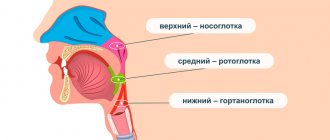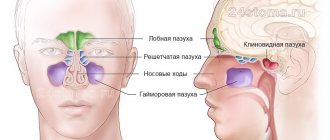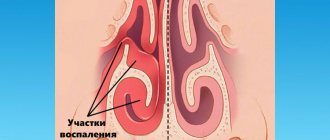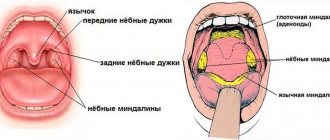Laryngitis is an inflammatory lesion of the mucous membrane of the larynx. The causes are infectious diseases, colds, as well as weakened immunity. Accompanied by swelling, local hyperemia of the throat, pain and other symptoms of intoxication. Treatment should be carried out on time, otherwise the trachea and other respiratory organs may be involved in the inflammatory process, provoking the appearance of laryngotracheitis and other pathological conditions.
Anatomy of the larynx
The larynx is a complex organ, which is a complex of various tissue structures with a developed network of blood, lymphatic vessels and nerves.
The larynx is a hollow air-carrying organ, which is given rigidity by cartilage. The larynx opens from above into the laryngopharynx, and from below it passes into the trachea.
Inside, the larynx is covered with a thin mucous membrane of cylindrical ciliated epithelium, and in places of mechanical load (epiglottis, posterior wall of the larynx, free edges of the vocal folds) with more durable stratified squamous epithelium.
The skeleton of the larynx consists of 5 main cartilages:
- three unpaired (cricoid, thyroid and epiglottis);
- two paired (arytenoid cartilages);
The vocal folds are two muscular-ligamentous cords of a whitish-pearl-colored color.3
The larynx provides a number of important functions:
- respiratory
- phonatory (voice)
- protective
- cough
- expectorant
- speech-forming (it is based on respiratory and vocal functions)
Chronic atrophic pharyngitis
A disease in which the mucous membrane of the larynx thins (atrophies) and its function is impaired. The mucous membrane of the larynx consists of multirow ciliated epithelium (except for the vocal folds). On its surface there are special cilia that are responsible for the movement of mucus in the programmed direction; in the thickness of the mucosa there are goblet cells that secrete viscous mucus, and in the submucosal layer there are tubular glands that secrete liquid mucus. With chronic atrophic pharyngitis, the number of cilia of the ciliated epithelium decreases (sometimes almost to their complete absence). The quantity and quality of mucus secreted by the glands decreases, and the thickness of the mucous membrane decreases. This disease occurs as a consequence of long-term catarrhal laryngitis. Iron deficiency anemia and vitamin deficiency may also be causes. Prof. plays an important role. hazards - hot and dry air, industrial dust, particles of volatile compounds. Atrophic laryngitis often occurs after radiation and chemotherapy. One of the factors, but little studied, is the genetic factor.
Symptoms: dry cough, sore throat, discomfort in the throat, dryness, change in timbre and voice fatigue. Complaints of dryness, sore throat, and sore throat come first, as this greatly worries the patient; complaints of a change in voice fade into the background.
Upon examination, the mucous membrane of the larynx is dry or drier than normal, with overlays of mucous crusts, and often has a “varnished” appearance. The vocal folds do not change much; breathing difficulties, as a rule, are not noted.
Treatment: it is difficult to treat this disease, since changes in the mucous membrane can be irreversible. If occupational hazards are identified, they must be excluded. Drug treatment is the prescription of alkaline inhalations for a long time and oral medications with a regenerative effect (Aloe extract, Mumiyo, vitamins, dexpanthenol), iron supplements for iron deficiency.
Causes of laryngitis
The cause of croup is most often a viral infection:
| CAUSES | A COMMENT | ||
| causes: | Infections | a comment: | The cause of acute laryngitis can be an infection that penetrates the mucous membrane of the pharynx and larynx and is easily activated against the background of a decrease in general and local immunity. The main causative agents of acute and chronic laryngitis include mainly streptococci and staphylococci, which can be activated under the influence of unfavorable factors. |
| causes: | Non-infectious causes | a comment: | — smoking and alcohol — chemical and thermal burns of the larynx — allergies — severe vocal strain |
Risk factors for developing acute laryngitis:
- decreased immunity
- general and local hypothermia
- diseases of the pharynx and paranasal sinuses
- influence of bad habits
Acute inflammation of the mucous membrane of the larynx may be a consequence of catarrhal inflammation of the nasal mucosa, paranasal sinuses (sinusitis) or pharynx (tonsillitis, pharyngitis).
Acute laryngitis develops against the background of viruses:
- ARVI
- influenza A, B, and C viruses
- parainfluenza
- adenovirus infection4
Among bacteria, common causative agents of acute laryngitis are:
- Haemophilus influenzae (H. Influenzae)
- chlamydia pneumoniae
- Moraxella catarrhalis
- pneumococcus (S. pneumoniae)5
Complications of laryngitis
If left untreated, the acute form of laryngitis can become chronic. The infection can also spread to the pharynx and lower respiratory tract, in which case we are talking about the development of pharyngitis and tracheitis. However, with ARVI, as a rule, the infection progresses in a descending manner and first develops rhinitis, pharyngitis, and then the larynx and lower respiratory tract are involved in the process.
One of the complications of chronic laryngitis is a change or complete absence of voice.
The most severe complication of laryngitis may be laryngeal stenosis; the development of this complication is possible in the case of acute subglottic laryngitis (croup). In case of stenosis, the patient needs immediate medical attention, in some cases an emergency tracheostomy is performed.
Classification of acute laryngitis
Catarrhal laryngitis
The most common form of the disease. Acute laryngitis is characterized by catarrhal inflammation of the laryngeal mucosa without signs of stenosis. Catarrhal laryngitis is the simplest form of laryngitis, which is treated on an outpatient basis
Edema laryngitis
Characterized by swelling of the mucous and submucosal layer of the larynx. Clinical manifestations of edematous laryngitis depend on the size of the edema. The causes are angio-neurotic (Quincke's edema) and allergic.
Phlegmous laryngitis (abscess)
Acute laryngitis with the formation of an abscess in the area of the epiglottis or aryepiglottic folds.
Pharyngitis
Pharyngitis is an inflammation of the mucous membrane of the pharynx2, which is located between the nasal cavity and the larynx2. Moreover, in the pharynx several sections are conventionally distinguished - the nasopharynx, oropharynx and laryngopharynx4.
The pharynx is simultaneously involved in three important acts - breathing, swallowing and voice formation7.
Acute pharyngitis is most often associated with infection, in 70% of cases with ARVI7, while viruses often “pave the way” for bacteria7, that is, they contribute to the addition of a bacterial infection.
As with inflammation of the tonsils, pharyngitis can be caused by group A7 beta-hemolytic streptococcus. But in 90% of cases, the inflammatory process is triggered by 2-3 types of bacteria at once7.
The following factors contribute to the development of chronic pharyngitis7:
- inhalation of dusty, hot, dry or smoky air;
- nasal congestion, due to which a person is forced to breathe through the mouth;
- injuries, such as those caused by tonsil removal;
- allergies to pollen or food products;
- hormonal disorders during menopause, hypothyroidism (thyroid hormone deficiency);
- lack of vitamin A, metabolic disorders, diabetes;
- abuse of vasoconstrictor nasal drops, due to which the mucous membrane of the nasopharynx does not receive enough blood;
- disturbance of intestinal microflora;
- diseases of the heart, kidneys, lungs.
Also, diseases of the gastrointestinal tract, such as gastroesophageal reflux disease (GERD), are often hidden behind the mask of chronic pharyngitis. It is associated with the reflux of acidic stomach contents into the esophagus and then into the pharynx7.
With pharyngitis, a person usually complains of:
- dryness6, sore throat or pain when swallowing, which “radiates” to the ear or lower jaw7;
- discomfort associated with the feeling of a “lump of mucus” - it makes you want to cough up7;
- coughing6, dry and sometimes paroxysmal cough7;
- the need to swallow mucus that accumulates on the back of the throat7.
Acute pharyngitis or exacerbation of chronic pharyngitis may be the first symptoms of measles, scarlet fever and rubella7. To exclude these infections, if a rash appears, you need to consult a specialist - a therapist, pediatrician or infectious disease specialist.
Symptoms of acute laryngitis
With the catarrhal form of laryngitis, the following complaints are observed:
- a sore throat
- sore throat
- hoarseness, hoarseness, loss of voice
- dry or wet cough
- difficulty breathing when inhaling
- dyspnea
- deterioration in general health, headache, weakness
- increase in body temperature to 37.1-38.06
Symptoms of laryngitis in phlegmonous (asbestos) form::
- difficulty swallowing
- dyspnea
- febrile temperature (38-39 degrees) reflects the addition of inflammation or the transition of catarrhal inflammation of the larynx to phlegmonous
- there is increasing symptomatology of laryngeal stenosis
Tonsillitis
Tonsillitis is an inflammation of the palatine tonsils2, which with their free part face the inside of the pharynx4.
The palatine tonsils are a collection of lymphoid tissue, an important part of the body's immune system. Tonsils protect the upper respiratory tract from infection8.
Although tonsillitis is still called tonsillitis, this term applies only to acute forms of the disease. If inflammation of the tonsils persists and periodically worsens, they speak of chronic tonsillitis2.
In this case, the cause of acute or chronic tonsillitis can be various pathogens:
- Viruses . In both adults and children, acute tonsillitis is most often associated with a viral infection18. Among the viruses that attack the tonsils, there are pathogens of ARVI (acute respiratory viral infection) - adenoviruses, parainfluenza viruses, rhinoviruses, respiratory syncytial viruses2,4. Also often the culprits of acute tonsillitis are herpes simplex viruses (HSV 1,2 and 3 types)4, cytomegaloviruses and Epstein-Barr virus2.
- Bacteria . They most often cause chronic tonsillitis2. Group A beta-hemolytic streptococcus is especially isolated. It is associated with the development of 20–30% of sore throats in children over 3 years of age2 and 20% of cases of sore throat in adults3.
- Fungi . Fungal tonsillitis can occur after the use of antibiotics, against the background of a weakened immune system or chronic diseases, such as diabetes4. Typically, the palatine tonsils are affected by candidiasis, an inflammation caused by fungi of the genus Candida4.
The following factors also contribute to the development of tonsillitis2:
- general and local hypothermia;
- lack of B vitamins;
- air pollution;
- violation of nasal breathing;
- inflamed teeth and gums.
The main symptoms of the disease include:
- moderate to severe sore throat that gets worse with swallowing and talking2,4;
- redness, enlargement of the tonsils and the appearance of plaque on them4;
With acute tonsillitis and exacerbation of chronic tonsillitis, body temperature often rises, headaches occur, weakness and general weakness appear. Cervical lymph nodes may become enlarged, hardened, and painful2,4.
Tonsillitis caused by group A2 beta-hemolytic streptococcus is especially severe. If left untreated, there is a risk that streptococcal infection will enter the bloodstream and spread to other organs. In chronic tonsillitis, autoimmune diseases often occur that affect the kidneys (glomerulonephritis), blood vessels (vasculitis), heart and joints (rheumatism)2. Therefore, for any form of tonsillitis you need to consult a doctor. This way you can receive timely and correct treatment and avoid complications.
Acute respiratory failure with laryngitis
The severity of clinical manifestations is directly related to the severity of inflammatory changes.
The main symptom of acute respiratory failure is shortness of breath. The following degrees are distinguished depending on severity:
- I degree of respiratory failure – shortness of breath that occurs during physical exertion.
- II degree – shortness of breath that occurs with little physical activity (slow walking, washing, dressing).
- III degree – shortness of breath at rest.7
Diagnosis and treatment of laryngitis at NEARMEDIC
The main goal of diagnosis for laryngitis is to identify its root cause. Experienced otolaryngologists of NEARMEDIC, during a conversation, physical examination and laryngoscopy, can establish a preliminary diagnosis at the first consultation. But to identify the cause of inflammation of the larynx, as well as to exclude diseases with similar symptoms, additional examination may be necessary, which includes:
- consultation with doctors of other specialties;
- indirect and direct endoscopic laryngoscopy;
- clinical blood test;
- microbiological examination of sputum or throat swab to identify pathogenic microflora and its response to antibiotics;
- computed tomography of the neck;
- magnetic resonance imaging of the soft tissues of the neck;
- histological examination of laryngeal tissue.
Depending on the diagnostic results, therapeutic measures are prescribed. An individual treatment plan may include conservative and surgical therapy.
In conservative treatment, drugs are prescribed in accordance with the identified agent - specially selected antibiotics, antiviral and antihistamines. At the same time, a disease is treated, of which laryngitis is a component. Anti-inflammatory rinses, emollients, alkaline and oil inhalations, cauterization of hypertrophied areas, immunomodulators, proteolytic enzymes, etc. are prescribed. Physiotherapeutic procedures are indicated - UHF, magnetic therapy, quartz treatment, etc.
In the presence of large nodules or the formation of polyps, to prevent malignancy of the resulting excess tissue, operations are performed to remove them surgically under local or general anesthesia. Both scalpel and radio wave or laser techniques are used, depending on the indications. Timely surgical treatment leads to recovery within a few months.
Make an appointment with an otorhinolaryngologist from the NEARMEDIC network of multidisciplinary clinics at your place of residence, work or study by calling the specified phone number or using the feedback form on the website.
Clinical picture of acute laryngitis upon examination
The main method for diagnosing laryngitis is instrumental and endoscopic laryngoscopy.
For catarrhal laryngitis:
- the mucous membrane of the larynx is red and swollen
- vocal folds are pink or bright red, thickened, mobile, do not close completely
- mucous or mucopurulent secretions may accumulate, which can cause a wet cough
Depending on the form of acute laryngitis, swelling and hyperemia (red mucous), the size of the epiglottis, and narrowing of the lumen of the larynx can be expressed in different ways.
In the complicated (abscessing) form, a spherical formation with translucent purulent contents is determined in the area of the epiglottis.
With stenosis of the larynx, a narrowing of its lumen occurs.
Diagnostics
Phlegmonous laryngitis should be distinguished from laryngeal edema, laryngeal tonsillitis and acute laryngeal perichondritis. With swelling there are no signs of inflammation, it differs in color and has a jelly-like consistency. The course of perichondritis is quite similar to the development of phlegmonous laryngitis, however, laryngitis is acute in nature and with it an abscess and the development of edema are observed.
Laryngeal stenosis
According to the clinical course and size of the airway lumen, four degrees of laryngeal stenosis are distinguished:8
- Stage of compensation - the lumen of the glottis is 6-8 mm or the narrowing of the tracheal lumen by 1/3
- Stage of subcompensation - glottis 3-4 mm, tracheal lumen narrowed by ½ or more
- Stage of decompensation - glottis 2-3 mm, slit-like lumen of the trachea
- Asphyxia - glottis and/or tracheal lumen 1 mm
!A thorough examination of the larynx can only be performed by an otorhinolaryngologist. The patient cannot independently examine himself and assess the severity of the condition.
Causes and course of the disease
Acute laryngitis can have a catarrhal, edematous and phlegmonous form of the inflammatory process. Acute catarrhal laryngitis can occur as an independent disease or accompany certain infections of the upper respiratory tract, bronchi and trachea. This disease may be part of the ARVI symptom complex, which includes influenza, adenoviral infections, and parainfluenza. In this case, almost the entire mucous membrane of the upper respiratory tract is involved in the inflammatory process. But acute catarrhal laryngitis can be one of the symptoms of the following diseases: rheumatism, whooping cough, measles, typhoid.
Acute catarrhal laryngitis, as an independent disease, occurs when the flora that lives and multiplies in the larynx is activated under the influence of the following factors:
- Hypothermia;
- Alcohol abuse;
- Smoking;
- Exposure to adverse household and industrial factors - dust, gas contamination, smoke, vapors, etc.
- Overstrain of the vocal folds during a strong cry or a long loud conversation.
The disease can be caused by staphylococci, streptococci, fungal and chlamydial infections. During the inflammatory process, loosening is observed not only of the mucous membrane itself, but also of the connective tissues and elastic fibers located in the submucosal layer. In addition, a change occurs in the secretory function of the glands, which leads to an increase in the amount of secretion and its retention. Blood vessels dilate and fill with blood. When the inflammatory infiltrate spreads to the muscles located in the larynx, a violation of tone occurs in the true vocal cords.
Treatment of acute laryngitis 9
Treatment of acute laryngitis requires an integrated approach.
Antibacterial therapy
Antibacterial therapy is not required for patients with mild forms of laryngitis. In case of severe inflammatory phenomena, with complicated forms of acute laryngitis, with the development of an abscess, as well as with exacerbations of chronic laryngitis, broad-spectrum antibacterial drugs (amoxicillin/clavulanic acid, cephalosporins of III–IV generations) or respiratory fluoroquinolones are prescribed.
Symptomatic therapy
Includes taking antipyretic and painkillers.
Inhalation therapy
Indicated for patients with any form of laryngitis, including abscesses.
Inhalations can be used as monotherapy for uncomplicated forms of laryngitis, as a symptomatic treatment to moisturize the laryngeal mucosa, and also in combination with other treatment methods for inflammatory diseases of the larynx.
In inhalation form, drugs are used that have antibacterial, antifungal, decongestant, mucolytic, anti-inflammatory effects, as well as the ability to moisturize the mucous membrane.
The main advantage of inhalations is the ability to achieve a quick and effective therapeutic effect using a small dose of the drug with a significant reduction in the negative systemic effect. During inhalation, drugs are rapidly absorbed. A high concentration of the drug is created directly at the site of inflammation.
Antihistamines
Prescribed for allergic forms of acute laryngitis.
Anti-edematous and anti-inflammatory therapy
Antifungal drugs are prescribed when a fungal infection is diagnosed.
Mucolytic drugs
Other treatment recommendations:
- vocal rest - it is recommended to talk as little as possible, avoid shouting, loud speech and whispering
- gentle diet - it is not recommended to eat spicy, salty, too hot or cold foods
- quitting smoking and alcohol
If treatment is ineffective or complications occur, hospitalization is indicated. If necessary, surgical intervention is performed.
Indications for emergency hospitalization are complications of acute laryngotracheitis:
- edematous laryngitis
- epiglotite
- abscesses of the epiglottis, complicated forms of the disease (infiltrative and abscessive)
- threat of developing laryngeal stenosis
After an illness, the recovery period lasts 2 weeks. When undergoing surgery, observation by an otolaryngologist for several months is recommended.
Chronic laryngitis
Chronic laryngitis is an inflammation of the mucous membrane of the larynx lasting more than 3 weeks. Timely diagnosis and adequate treatment of this pathology are extremely important, since it is a social problem that leads to disability in voice-speech professions - vocalists, actors, teachers, and tour guides. Malignancy of the inflamed cells of the larynx may occur, i.e., their degeneration into a cancerous tumor.
Causes of chronic laryngitis
A role in the development of chronic inflammatory process in the larynx is played by:
· frequent acute laryngitis;
· chronic foci of infection of other localization (deviated nasal septum, sinusitis, pharyngitis, tonsillitis, otitis, caries);
· opportunistic microflora of the oral cavity;
· concomitant somatic pathology, in particular GERD (with this disease, the acidic contents of the patient’s stomach are thrown into the esophagus, burning the mucous membrane, which creates favorable conditions for the proliferation of microorganisms in this area);
· metabolic diseases (in particular, diabetes mellitus);
· dust, food, chemical allergens;
· regular excessive load on the vocal apparatus;
· working or living in conditions of severe air pollution with dust or chemicals;
· sudden changes in temperature;
· smoking and drinking alcohol;
· decrease in the overall resistance of the body.
Chronic laryngitis: symptoms and diagnosis
The leading symptom of chronic inflammation of the larynx is a change in the timbre of the voice, its hoarseness. The disease can manifest itself as a constant feeling of dryness, soreness, discomfort in the throat, a feeling of the presence of a foreign body or coma in it. Patients are bothered by coughs of varying intensity - from constant coughing to paroxysmal painful coughs. During the period of remission, the above symptoms are mildly expressed, and during exacerbation their intensity increases, body temperature rises to subfebrile levels, and complaints of weakness, fatigue and headache may appear.
The diagnosis is made on the basis of the patient’s complaints, taking into account the medical history and life history, and is confirmed by laryngeal or video endoscopy - a simple examination of the larynx area or examination of it using a video endoscope device. In some cases, for the purpose of accurate diagnosis, microlaryngoscopy (examination of the laryngeal mucosa under a microscope) is used. If a malignancy of the process is suspected, a puncture biopsy is performed during a laryngoscopic examination - sampling of the affected cells with a special needle for subsequent histological examination.
Depending on the morphological changes in the laryngeal mucosa and the predominant symptoms of the disease, acute laryngitis is usually divided into 3 forms: catarrhal, hypertrophic and atrophic.
In the catarrhal form of chronic laryngitis, the mucous membrane of the larynx is diffusely thickened, moderately hyperemic, and blood vessels are visualized on the swollen vocal folds. During phonation, the glottis does not close completely. This form of the disease is manifested by constant hoarseness, a sore throat, and rapid voice fatigue. In addition, patients are occasionally bothered by a moderately intense cough with clear or whitish sputum.
Chronic hypertrophic laryngitis can be diffuse or localized. In the diffuse form, the mucous membrane of the larynx is uniformly swollen; in the case of a limited form, symmetrically located connective tissue tubercles are visualized in the area of the vocal folds (singers’ nodules in adults, screamers’ nodules in children). A characteristic clinical sign of hypertrophic laryngitis is severe hoarseness of the voice, up to its complete absence - aphonia.
In the atrophic form of chronic inflammation of the larynx, its mucous membrane is dry, thinned, covered with thick mucus and crusts. Clinically, the disease is manifested by a constant feeling of soreness and dryness in the throat, an annoying dry cough, in which crusts streaked with blood come off. Hoarseness during the day is expressed differently: in the morning it is stronger, after clearing the throat it decreases.
Chronic laryngitis: treatment
Unfortunately, it is impossible to completely get rid of this disease, so treatment of chronic laryngitis in adults should be aimed at reducing its manifestations and improving the patient’s quality of life.
Non-drug methods are of great importance in the treatment of chronic inflammation of the larynx:
· to give up smoking;
· vocal rest;
· gentle nutrition (warm, soft, neutral-tasting food, exclusion of spicy, hot and cold foods, carbonated drinks);
· drink plenty of water (alkaline mineral waters (Essentuki, Borjomi), warm milk with honey);
· prevention of hypothermia;
· ventilate the room in which the patient lives for 10 minutes every hour;
· adequate microclimate (temperature and humidity) in the room.
An important component of the treatment of chronic laryngitis is the timely treatment of its accompanying pathology (sanitation of chronic foci of infection, correction of blood glucose levels, treatment of GERD).
Treatment of chronic catarrhal laryngitis
This form of the disease is very treatable. In addition to the above non-drug measures, drug therapy is also used:
· antiviral drugs (interferon inducers, Groprinosin);
· if necessary, systemic antibiotics (Amoxiclav, Moexipril);
· oil and alkaline inhalations;
· antitussives (Codeine);
· expectorants (preparations of marshmallow, ivy, plantain) and mucolytic (Acetyl-, Carbocysteine, Ambroxol, Bromhexine) agents;
· local anti-inflammatory and analgesic drugs (Isla lozenges, Neo-angin, Decatylene, Angilex sprays, Tera-flu, Ingalipt);
· local antibacterial drugs (Bioparox);
· multivitamin preparations (Duovit, Multitabs);
· immunomodulators (Respibron, Ribomunil);
· preparations containing bacterial lysates (IRS-19).
In a hospital setting, infusions of medications into the larynx using a special laryngeal syringe are also prescribed - so-called instillations.
When the symptoms of an exacerbation regress, the use of physiotherapeutic methods of treatment is recommended:
Novocaine electrophoresis;
· UHF;
· DDT.
Treatment of chronic atrophic laryngitis
If appropriate symptoms are present, the same remedies are used that are recommended for the treatment of the catarrhal form of the disease. A feature of the treatment of atrophic laryngitis is inhalation of proteolytic enzymes (Chymotrypsin, Trypsin) in the form of aerosols.
Treatment of chronic hypertrophic laryngitis
- Depending on the patient’s condition, treatment can be conservative (include all or some drugs from the above groups) or surgical. The essence of the latter is that under general anesthesia under the control of a microscope, an ENT surgeon removes hyperplastic tissues or neoplasms of the larynx.
- In our clinic, this technique is performed using a molecular resonance apparatus. The method of molecular resonance surgery is a new stage in the development of electrosurgery, which is based on the use of currents that cause the formation of molecular resonance in tissues. When using a molecular resonance apparatus, the temperature in the incision area does not exceed 45-50 degrees Celsius, which eliminates the formation of a zone of thermal necrosis and charring of the edges of the incision, thereby reducing postoperative inflammation.
- This method is less traumatic compared to the instrumental one, the risk of bleeding in the postoperative period is reduced, and there is also a faster recovery after surgery.
Prevention of acute laryngitis
- giving up bad habits such as smoking, drinking alcohol. These factors often cause the process to become chronic
- respiratory protection when working with chemicals
- timely diagnosis and treatment of diseases of the ENT organs, such as sinusitis, pharyngitis, tonsillitis
- prevention of ARVI and other viral diseases
There are individual prevention measures aimed at strengthening the body’s protective properties:
- avoiding general and local hypothermia
- hardening the body, exercising, regularly spending time in the fresh air
- consuming enough vitamins from food
- consumption of vitamins and dietary supplements (BAS), rich in various vitamins, minerals, nutrients, and substances of plant origin to strengthen health and immunity, and prevent colds.
Tantum® Propolis
It is important to choose the right biological supplement, focusing on the body’s needs and its problem.
For example, Tantum® Propolis lozenges can help strengthen the immune system. 16 Find out more
Not being a medicine, Tantum®Propolis can support the patient’s immunity during seasonal ARVI and influenza, reduce pain, irritation and itching in the throat, and also replenish the lack of vitamins in the patient’s body.
Treatment methods
In the case of laryngitis, therapeutic measures must be comprehensive. Patients, according to the form of the pathology, are prescribed medications, inhalations, physiotherapy, also bed rest and warm, abundant fortified drinks.
It is necessary to avoid straining the vocal cords; it is forbidden to eat hot, cold, or spicy food. To correct dry air, it is useful to use a humidifier.
To speed up the healing process, it is necessary to increase the body's defenses. For this purpose, vitamins, immunomodulators and a delicate balanced diet are prescribed.
FAQ
How to treat laryngitis at home?
For uncomplicated acute laryngitis and in the first days of the disease, it is recommended:
- ensure vocal rest, eliminate whispered speech , in which the vocal folds become even more tense
- plenty of warm drinks: you can drink warm milk with soda, warm mineral degassed water, teas and fruit drinks
- if laryngitis is accompanied by inflammation in the throat, it is recommended to rinse with a solution of chamomile or calendula, as well as the use of sprays, solutions or tablets to treat the throat
- inhalations are the main method of treating laryngitis. Self-inhalation can only be done using saline solution. Other drugs for inhalation are prescribed exclusively by a doctor.
Is it possible to quickly cure laryngitis?
For acute catarrhal laryngitis caused by viruses, recovery is possible within a week. It is important to consult a doctor in time and not self-medicate so as not to worsen the condition.
What syrups and tablets can be taken for laryngitis?
The use of local drugs for the treatment of the throat in the form of lozenges, sprays and rinses is permissible only if laryngitis is caused by throat diseases. These forms of drugs do not directly enter the lumen of the larynx.
How to treat false croup in a child?
When the first symptoms of croup appear, you should call an ambulance.
Only a doctor will be able to assess the severity of the child’s condition, as well as determine further treatment and observation tactics. Outpatient observation and treatment is permissible only for grade 1 stenosis. Self-medication and the use of folk remedies are excluded in this case!
Treatment of catarrhal laryngitis
Treatment of catarrhal laryngitis is carried out in our specialized clinic using modern techniques. All treatment of catarrhal laryngitis with us pursues the following goals:
- Relieve the patient of laryngitis symptoms;
- Eliminate the root cause of the disease;
- Make treatment as painless, effective and safe for the patient as possible;
- Prevent the development of relapse, as well as the transition of the disease to a chronic form.
Treatment of catarrhal laryngitis in our clinic uses the following reliable methods:
- Photodynamic therapy, which allows you to eliminate inflammation in the larynx in a short time, and also returns the normal protective function of the oropharyngeal mucosa, eliminating the unwanted pathogenic background;
- Mineral therapy - which, using irrigation of the oropharynx, makes it possible to get rid of pathogenic microorganisms located on the mucous membrane of the oral cavity and larynx;
- Organo-, ozone therapy - which increase the overall immune resistance of the body.
All our methods of treating catarrhal laryngitis make it possible not only to get rid of the disease in a short time, but also to reliably eliminate the disease, preventing its further spread and complications with other diseases.








